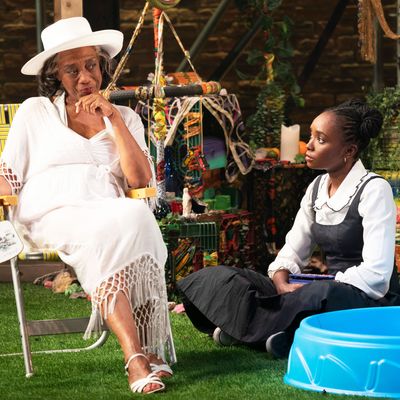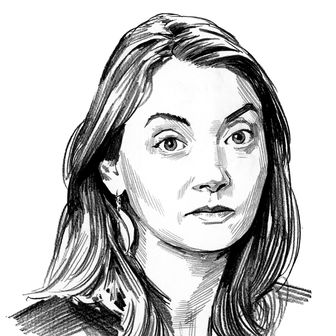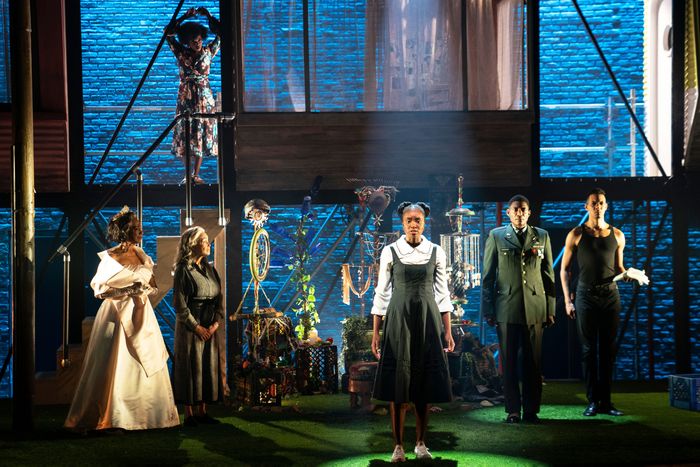
Aleshea Harris’s On Sugarland takes place in a small cul-de-sac at the end of Tiparoo Lane. It’s more than a dead end: It’s a dying end, where all the death in a small Southern town collects like water from a drainspout. People do live on Tiparoo, but they’re Black and poor and the military scoops them up for service, usually sending them home in boxes. Once they’re home, they’re memorialized in Sugarland, a yard-show cenotaph made from army boots and painted bicycle wheels and dog-tag chandeliers. Sugarland’s folk-art grotto fills a single mobile home’s front garden, but everyone still manages to fit inside for the community funerals called “hollerings.” They happen throughout On Sugarland, more frequently as the play goes on. One character refers to the cul-de-sac as “where the end of Tiparoo Lane becomes a mouth,” but really the mouth is the unnamed war, gobbling everybody up.
Harris already has two major New York productions behind her: Is God Is, a Western revenge comedy with chilling references to domestic homicide, and What to Send Up When It Goes Down, a participatory homegoing for Black people killed by police. The former depended on a genre structure as old as the hills; the latter seemed older than that, using ritual strategies that probably predate the use of fire. It turns out that Harris’s lyric excess — her characters speak in dazzling torrents — needs such old, strong bones. In On Sugarland she scales up and out, inviting in more characters than she can safely handle, calling on myths and multiple framing techniques that shake her own storytelling abilities to their roots. The play flexes in both senses of the word. It shows off Harris’s impressive poetic muscles, but it also bends out of true, warping a little from what she asks it to contain.
The first person we meet on Tiparoo Lane is 14-year-old Sadie (KiKi Layne), a traumatized child whose missing mother Iola has finally been declared Presumed Killed in Action by the military. Sadie cannot or will not talk. We can hear her though, and her inner speech is powerful: She can wake the dead. At various points during On Sugarland, Sadie relays her psychic conversations, all with her matrilineal ancestors. Sadie just wants information about Iola, but her foremothers are too preoccupied with their own stories to help. Of course the family’s gift for violence hints at what might have happened. Eventually Sadie will figure it out.
Sadie’s sight goes clear through to the other side, but everyone else seems to be staggering in a haze. Sadie’s aunt Odella (the astonishing Adeola Role) drinks to forget her own dead deserter lover; her veteran neighbor Saul (Billy Eugene Jones) takes mind-blurring medication for a war wound that won’t heal. Saul’s troubled 17-year-old son, Addis (Caleb Eberhardt), can’t see anything other than his own delusions of military glory. Even the town elders seem blinkered: Tisha (Lizan Mitchell) tends Sugarland, not noticing her own sister Evelyn (Stephanie Berry), whose gloating monologues (“O, o her bosom. Plump but soft!” she says, looking in the mirror) and brisk, insulting humor clearly conceal something important. Evelyn is an incredible character, and Berry gives her such brio and spark that she has almost enough life force to counteract the death obsession all around her. Eventually, though, she bows to it. Even members of the young chorus, called The Rowdy, think only of the honored dead — costume designer Qween Jean puts one in an Aaliyah T-shirt, and later another young actor shows up with Tupac on their chest.
You could watch all of On Sugarland and enjoy it and get it and never worry about Harris’s connections to Sophocles. Still, they’re there, subterranean allusions running far beneath the cul-de-sac. Saul’s weeping wound, the foot that won’t be cured, is borrowed from Philoctetes, in which a warrior with a stinking injury has been ostracized by his fellow Greeks. Saul, like Philoctetes, is a figure of both religious veneration and disgust; the extreme nature of his suffering throws him outside life’s mundane framework, knocking him into the realm of the quasi-divine. (Men don’t care what happens to him, but the gods certainly do.) Odella’s late-play impassioned monologue about her deserter boyfriend makes her sound like Antigone, another woman determined to secure “proper” burial for a loved one, and Sadie overlaps in interesting ways with Electra, the orphan who mourns an empty box (this is an urn in the Sophocles), even though others know it contains a lie.
In fact, anywhere your eye looks in On Sugarland, it catches on something ancient. In the shrine itself, Trish has put up an altar tree, blue bottles on its branches, which keep the spirits in (or let them out). That’s a tradition that survived the Middle Passage: Historians say the Kongo were making bottle tree altars at least as far back as the ninth century. Harris is clearly interested in plowing deep, and what she delves for, she finds. It’s only her more practical elements that don’t work — relatively shallow things like the orchestration of characters’ stories, how the plot fits together, what constitutes the climax (and whether we’re prepared for it). Since it’s the big picture where Harris falters, our attention turns to her parts rather than her whole. But what parts! Several of the speeches are the finest this season. Role delivers Odella’s breakdown like an aria — we should have thrown flowers — and Evelyn keeps stealing the show in monologue after monologue. The one she delivers to Sadie had the audience shouting with praise.
What do some people have against leisure, I wonder?
Or is it just that they despise women like us so much that they can’t stand the idea of us enjoying ourselves, enjoying our beauty. You know how to make, pardon my language, a motherfucker mad?
Love this living. Mm hmm.
Love it in your fingernails and to the edges of your hair follicles. Motherfuckers hate that.
To serve such a baroque, hyperdecorated, full-to-bursting play, the production needs a balance — some sort of restraint, somewhere. Director Whitney White hasn’t got quite the steadiness of touch to do that. She does beautiful work with two-character scenes, prompting delicate exchanges, turning comic lines with a carpenter’s precision, but once there are more than four people onstage, her control ebbs. She directed What to Send Up as well, and that show needed only a chalk circle on the floor. The partnership between her mind and Harris’s seems to flourish in that more ascetic environment.
Certainly Adam Rigg’s set design crams too much in, perching portions of three mobile homes on a scaffolding that crowds around a round grassy play area. Ringing this platform are a circular set of train tracks, which people sometimes clamber over. He does a gorgeous job with the Sugarland memorial itself, but everywhere else is crowded, even impassable. One of Harris’s strategies is to winnow her chorus over the course of the show as increasing numbers of the young people are drafted or enlist. As we’re distracted by the set’s clutter, it’s hard to perceive that hollowing out. And where should the Rowdy dance? Choreographer Raja Feather Kelly sometimes has them stomp and step at the extreme sides of the stage, but there’s rarely room for him to create any sort of picture with their massed bodies. Once he has a dancer jump down off the stage to run across the room down on the audience level, and the exhilaration of that one unfettered movement hints at what he might have made with more space.
There’s enough in On Sugarland for three plays, and I wonder — maybe that too is a tribute to Harris’s ancient Greek forebears. (Sophocles would never have presented just one play at a festival; he would have presented three tragedies with a comic satyr-play chaser.) I heard a few grumbles as I walked away from New York Theater Workshop, people who seemed to think the two-hour-and-forty-five-minute running time was too long. No! We should have made a day of it. First Sadie, then Odella, then Saul would have gotten their own tragedies, each holding fast to the spiritual lightning bolt Harris is so good at conjuring. And then for her satyr play, we would have had Evelyn and Tisha, bickering and laughing, showing us exactly what all the Sturm und Drang had been about. All the troubles of On Sugarland come from trying to push everything together. Each story just needed a little more space, room to breathe — a grave of its own.
On Sugarland is at New York Theater Workshop through March 20.



